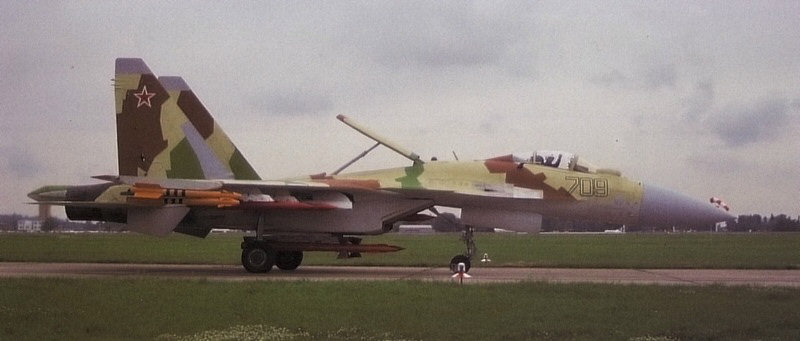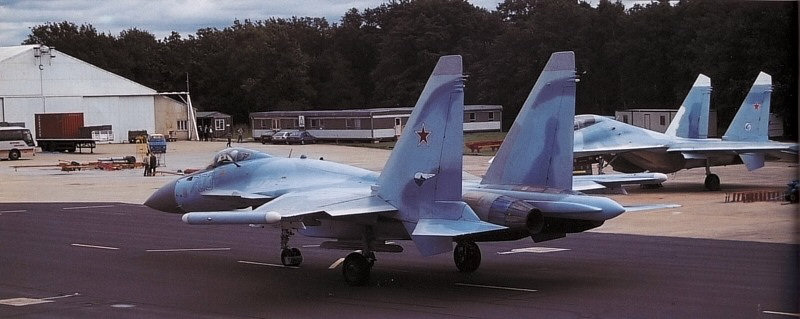In an atmosphere in which funding for existing aircraft projects was impossible, the Sukhoi OKB ensured continuing financial support for its advanced Su-27 derivative, initially designated Su-27M, by the simple expedient of redesignating it as Su-35. In contrast to Mikoyan's openness about its advanced MiG-29 derivatives, Sukhoi has remained remarkably tight-lipped about its Su-35 project. At Farnborough in September 1992, OKB designer general Simonov and project chief Nikolai Nikitin contradicted one another on several key questions when separately interviewed about the Su-35.
As far as can be ascertained, the project to develop an advanced version of the Su-27 was launched during the early 1980s, before the initial variant had entered service, with the primary aim of producing an aircraft with better dogfighting characteristics. A proof-of-concept aircraft with moving canard foreplanes, the T-70-24, first flew during 1982, and was the first of a confusing array of converted production aircraft used as testbeds, and newly built Su-27M 'prototypes'. Better agility (including higher Alpha limits and improved handling at high angles of attack) has reportedly been achieved through use of the canards, and through provision of heavy internal fuel tanks in the tailfins.
The aircraft is equipped with a completely new flight control system, with four longitudinal channels and three transverse. The channel for the canard foreplane also functions as a redundant channel. To compensate for the canards, the tailfin area has also been increased on some Su-35 prototypes, and the new, square-topped tailfin will reportedly be incorporated on any production Su-35.

The Su-35 is being agressively marketed by the Sukhoi OKB, and prototypes have been painted in several
eye-catching camouflage schemes.
In addition to the aerodynamic and control system improvements, Sukhoi has been working on vectoring engine nozzles and on various avionics improvements. Simple two-dimensional vectoring nozzles (similar to those flown on the F-15 S/MTD) have been tested on at least one Zhukhovskiibased Su-27UB, and are intended to be incorporated on any production Su-35 (if funding permits). Such nozzles could be retrofitted at a later date. A number of avionics improvements will definitely be incorporated in any production Su-35.
A new radar has been installed. Perhaps designated N-011, and probably similar in concept to the N-010 of the MIG-29M, it reportedly has a range of up to 400 km (248 miles) (or 200 km/124 miles against ground targets) and can simultaneously track more than 15 targets, and engage up to six. The aircraft also has advanced datalink equipment allowing the kind of group operation practised by the MiG-31, whereby a formation leader can directly and automatically control his wingmen's aircraft, receiving radar and sensor inputs from (and automatically redistributing to) all formation aircraft, ground stations and AWACS aircraft.
A cryptic reference to 'radar tracking of multiple targets in free air or on the surface, at both forward or rear hemisphere' is believed to allude to the function of a dielectric radome in the tailcone, which is believed to house the antenna for a rearfacing search radar. In February 1993, at an international conference, Major General Vassily Alexandrov, head of the Russian Federation air force's Central Scientific and Research Institute, revealed that a rearward-facing air intercept radar was under development for the Su-35 to allow 'overthe-shoulder' missile shots.
In service, the Su-35 will be able to carry up to seven examples of the new Novator KS-172 AAM-L ultra-long-range missile. Originally revealed with a range of 300 km (186 miles), this has a new solid-propellant booster section (which adds 1.4 m/4.6 ft to the 6-m/19.7-ft long missile), increasing effective range to 400 km (248 miles). Fitted with an active radar seeker, the missile also has inertial mid-course guidance and correction, and can be used at altitudes of up to 30000 m (98,425 ft).

The Su-35 differs from the basic 'Flanker' in having a new radar, flight control system and airframe
improvements. It also has tall square-topped fins.
The cockpit of the Su-35 features three large CRT MFD screens, each surrounded by 20 surprisingly crude input buttons, with a separate navigation display. No attempt seems to have been made to control these by HOTAS buttons, as in the MiG-29M. A sidestick controller was flown by a NIIAKM Su-27, but has not yet been incorporated in the Su-35. The new avionics give much better air-to-surface capability, conferring compatibility with a range of laser- (and perhaps TV-) guided air-to-ground weapons Automatic terrain following is also possible. A retractable inflight-refuelling probe makes possible a further increase in the Su-27's already impressive radius of action.
Nikitin claims that the first of six Su-27M/ Su-35 prototypes made its maiden flight on 28 June 1988, in the hands of Oleg Tsoi. In February 1993, Major General Alexander Yonov, director of operations and deputy chief of the Russian Federation air staff, stated that flight testing was complete and that production aircraft would enter operational service in the near future.
SPECIFICATION
Sukhoi Su-35
Generally similar to the Sukhoi Su 7/ Flanker-B except in the following particulars:
Wing:span 15.16 m (49 ft 8.75 in) over FSM pods
Fuselage and tail:length 22 183 m (72 ft 9 in) height 6.84 m (22 ft 5 in)
Powerplant:two NPO Saturn (Lyul'ka) AL-31 FM turbofans, each rated at 130.47 kN (29,321 lb st) with atterburning
Weights:empty (40,564 lb); normal take-off 26000 kg (57,319 lb), maximum take-off 34000 kg (74,956 lb)
Load:maximum external load 8000 kg (17,637 lb)
Speed:maximum level speed 'clean' at 11000 m (36,089 ft) 2500 km/h (1.349 kt; 1,553 mph) , and at sea level 1400 km/h (756 kt; 870 mph)
Range:at high-altitude with four AAMs 3500 km (1,889 nm; 2,175 miles; range at low altitude with four AAMs 1450 km/h
(783 nm, 901 miles); ferry range 4200 km (2.267 nm; 2610 miles), range with inflight refuelling in excess of 6800 km (3,670 nm; 4,225 miles)
